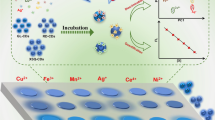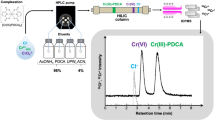Abstract
We on report an eco-friendly molecularly imprinted material based on carbon dots (C-dots) via a facile and efficient sol–gel polymerization for selective fluorescence detection of 4-nitrophenol (4-NP). The amino-modified C-dots were firstly synthesized by a hydrothermal process using citric acid as the carbon source and poly(ethyleneimine) as the surface modifier, and then after a sol–gel molecular imprinting process, the molecularly imprinted fluorescence material was obtained. The material (MIP-C-dots) showed strong fluorescence from C-dots and high selectivity due to the presence of a molecular imprint. After the detection conditions were optimized, the relative fluorescence intensity (F0/F) of MIP-C-dots presented a good linearity with 4-NP concentrations in the linear range of 0.2 − 50 μmol L-1 with a detection limit (3σ/k) of 0.06 μmol L-1. In addition, the correlation coefficient was 0.9978 and the imprinting factor was 2.76. The method was applicable to the determination of trace 4-NP in Yangtze River water samples and good recoveries from 92.6–107.3 % were obtained. The present study provides a general strategy to fabricate materials based on C-dots with good fluorescence property for selective fluorescence detection of organic pollutants.

An eco-friendly molecularly imprinted fluorescence sensor based on carbon dots (C-dots) (poly(ethyleneimine) (PEI) as the surface modifier) was prepared via a facile and efficient sol–gel polymerization (3-aminopropyltriethoxysilane (APTES) as the functional monomer and tetramethoxysilane (TEOS) as the cross linker) for selective fluorescence detection of 4-nitrophenol (4-NP).






Similar content being viewed by others

References
Yin H, Zhou Y, Han R, Qiu Y, Ai S, Zhu L (2012) Electrochemical oxidation behavior of 2,4-dinitrophenol at hydroxylapatite film-modified glassy carbon electrode and its determination in water samples. J Solid State Electrochem 16:75–82
Hu S, Xu C, Wang G, Cu D (2001) Voltammetric determination of 4-nitrophenol at a sodium montmorillonite-anthraquinone chemically modified glassy carbon electrode. Talanta 54:115–123
Li S, Du D, Huang J, Tu H, Yang Y, Zhang A (2013) One-step electrodeposition of a molecularly imprinting chitosan/phenyltrimethoxysilane/AuNPs hybrid film and its application in the selective determination of p-nitrophenol. Analyst 138:2761–2768
Liu X, Ji Y, Zhang Y, Zhang H, Liu M (2007) Oxidized multiwalled carbon nanotubes as a novel solid-phase microextraction fiber for determination of phenols in aqueous samples. J Chromatogr A 1165:10–17
Guo XF, Wang ZH, Zhou SP (2004) The separation and determination of nitrophenol isomers by high-performance capillary zone electrophoresis. Talanta 64:135–139
Valizadeh A, Mikaeili H, Samiei M, Farkhani SM, Zarghami N, Kouhi M, Akbarzadeh A, Davaran S (2012) Quantum dots: synthesis, bioapplications, and toxicity. Nanoscale Res Lett 7:480
Yuan C, Zhang K, Zhang Z, Wang S (2012) Highly selective and sensitive detection of mercuric ion based on a visual fluorescence method. Anal Chem 84:9792–9801
Xu X, Ray R, Gu Y, Ploehn HJ, Gearheart L, Raker K, Scrivens WA (2004) Electrophoretic analysis and purification of fluorescent single-walled carbon nanotube fragments. J Am Chem Soc 126:12736–12737
Baker SN, Baker GA (2010) Luminescent carbon nanodots: emergent nanolights. Angew Chem Int Ed 49:6726–6744
Zuo PL, Lu XH, Sun ZG, Guo YH, He H (2016) A review on syntheses, properties, characterization and bioanalytical applications of fluorescent carbon dots. Microchim Acta 183(2):519–542
Yan X, Cui X, Li B, Li L (2010) Large, solution-processable graphene quantum dots as light absorbers for photovoltaics. Nano Lett 10:1869–1873
Lu WB, Qin XY, Liu S, Chang GH, Zhang YW, Luo YL, Asiri AM, Al-Youbi AO, Sun XP (2012) Economical, green synthesis of fluorescent carbon nanoparticles and their use as probes for sensitive and selective detection of Mercury(II) ions. Anal Chem 84:5351–5357
Huang H, Li CG, Zhu SJ, Wang HL, Chen CL, Wang ZR, Bai TY, Shi Z, Feng SH (2014) Histidine-derived nontoxic nitrogen-doped carbon dots for sensing and bioimaging applications. Langmuir 30:13542–13548
Gao ZH, Lin ZZ, Chen XM, Lai ZZ, Huang ZY (2016) Carbon dots-based fluorescent probe for trace Hg2+ detection in water sample. Sens Actuat B: Chem 222:965–971
Chen LX, Xu SF, Li JH (2011) Recent advances in molecular imprinting technology: current status, challenges and highlighted applications. Chem Soc Rev 40:2922–2942
Alexander C, Andersson HS, Andersson LI, Ansell RJ, Kirsch N, Nicholls IA, O’Mahony J, Whitcombe MJ (2006) Molecular imprinting science and technology: a survey of the literature for the years up to and including 2003. J Mol Recognit 19:106–180
Ye L, Haupt K (2004) Molecularly imprinted polymers as antibody and receptor mimics for assays, sensors and drug discovery. Anal Bioanal Chem 378:1887–1897
Li Y, Ding MJ, Wang S, Wang RY, Wu XL, Wen TT, Yuan LH, Dai P, Lin YH, Zhou XM (2011) Preparation of imprinted polymers at surface of magnetic nanoparticles for the selective extraction of tadalafil from medicines. ACS Appl Mater Interfaces 3:3308–3315
Yin JF, Cui Y, Yang GL, Wang HL (2010) Molecularly imprinted nanotubes for enantioselective drug delivery and controlled release. Chem Commun 46:7688–7690
Xu SF, Chen LX, Li JH, Qin W, Ma J (2011) Molecularly imprinted core-shell nanoparticles for determination of trace atrazine by reversible addition-fragmentation chain transfer surface imprinting. J Mater Chem 21:12047–12053
Alizadeh T, Zare M, Ganjali MR, Norouzi P, Tavana B (2010) A new molecularly imprinted polymer (MIP)-based electrochemical sensor for monitoring 2,4,6-trinitrotoluene (TNT) in natural waters and soil samples. Biosens Bioelectron 25:1166–1172
Orozco J, Cortés A, Cheng GZ, Sattayasamitsathit S, Gao W, Feng XM, Shen YF, Wang J (2013) Molecularly imprinted polymer-based catalytic micromotors for selective protein transport. J Am Chem Soc 135:5336–5339
Liu HL, Fang GZ, Li CM, Pan MF, Liu CC, Fan C, Wang S (2012) Molecularly imprinted polymer on ionic liquid-modified C-dotse/ZnS quantum dots for the highly selective and sensitive optosensing of tocopherol. J Mater Chem 22:19882–19887
Wei X, Zhou ZP, Hao TF, Li HJ, Dai JD, Gao L, Zheng XD, Wang JX, Yan YS (2015) Simple synthesis of thioglycolic acid-coated CdTe quantum dots as probes for Norfloxacin lactate detection. J Lumin 161:47–53
Wei X, Zhou ZP, Hao TF, Li HJ, Yan YS (2015) Molecularly imprinted polymer nanospheres based on Mn-doped ZnS QDs via precipitation polymerization for room-temperature phosphorescence probing of 2,6-dichlorophenol. RSC Adv 5:19799–19806
Wei X, Zhou ZP, Hao TF, Li HJ, Xu YQ, Lu K, Wu YL, Dai JD, Pan JM, Yan YS (2015) Highly-controllable imprinted polymer nanoshell at the surface of silica nanoparticles based room-temperature phosphorescence probe for detection of 2,4-dichlorophenol. Anal Chim Acta 870:83–91
Wei X, Hao TF, Xu YQ, Lu K, Li HJ, Yan YS, Zhou ZP (2015) Swelling technique inspired synthesis of fluorescence composite sensor for highly selective detection of Bifenthrin. RSC Adv 5:79511–79518
Wei X, Hao TF, Xu YQ, Lu K, Li HJ, Yan YS, Zhou ZP (2016) Facile polymerizable surfactant inspired synthesis of fluorescent molecularly imprinted composite sensor via aqueous CdTe quantum dots for highly selective detection of λ-cyhalothrin. Sens Actuat B: Chem 224:315–324
Wei X, Zhou ZP, Hao TF, Xu YQ, Li HJ, Lu K, Dai JD, Zheng XD, Gao L, Wang JX, Yan YS, Zhu YZ (2015) Specific recognition and fluorescent determination of aspirin by using core-shell CdTe quantum dot-imprinted polymers. Microchim Acta 182:1527–1534
Rounaghi G, Kakhki RM, Azizi-toupkanloo H (2012) Voltammetric determination of 4-nitrophenol using a modified carbon paste electrode based on a new synthetic crown ether/silver nanoparticles. Mat Sci Eng C-Mater 32:172–177
Gu YE, Zhang Y, Zhang F, Wei J, Wang C, Du Y, Ye W (2010) Investigation of photoelectrocatalytic activity of Cu2O nanoparticles for p-nitrophenol using rotating ring-disk electrode and application for electrocatalytic determination. Electrochimi Acta 56:953–958
Xiao W, Xiao D, Yuan H (2007) A functionalized mesoporous silica sensor for the determination of p-nitrophenol or 2,4-dinitrophenol based on fluorescence quenching. Sens Lett 5:445–449
Moraes FC, Tanimoto ST, Salazar-Banda GR, Machado SAS, Mascaro LH (2009) A new indirect electroanalytical method to monitor the contamination of natural waters with 4-nitrophenol using multiwall carbon nanotubes. Electroanalysis 21:1091–1098
Yin H, Zhou Y, Ai S, Liu X, Zhu L, Lu L (2010) Electrochemical oxidative determination of 4-nitrophenol based on a glassy carbon electrode modified with a hydroxyapatite nanopowder. Microchim Acta 169:87–92
Ahmed GHG, Laíño RB, Calzón JAG, García MED (2015) Highly fluorescent carbon dots as nanoprobes for sensitive and selective determination of 4-nitrophenol in surface waters. Microchim Acta 182:51–59
Acknowledgments
This work was financially supported by the National Natural Science Foundation of China (No. 21277063, No. 21407057 and No. 21407064), National Basic Research Program of China (973 Program, 2012CB821500), Natural Science Foundation of Jiangsu Province (No. BK20140535), National Postdoctoral Science Foundation (No. 2014 M561595), Postdoctoral Science Foundation funded Project of Jiangsu Province (No. 1401108C).
Author information
Authors and Affiliations
Corresponding author
Ethics declarations
The author(s) declare that they have no competing interests
Electronic supplementary material
Below is the link to the electronic supplementary material.
ESM 1
(DOC 250 kb)
Rights and permissions
About this article
Cite this article
Hao, T., Wei, X., Nie, Y. et al. An eco-friendly molecularly imprinted fluorescence composite material based on carbon dots for fluorescent detection of 4-nitrophenol. Microchim Acta 183, 2197–2203 (2016). https://doi.org/10.1007/s00604-016-1851-2
Received:
Accepted:
Published:
Issue Date:
DOI: https://doi.org/10.1007/s00604-016-1851-2



